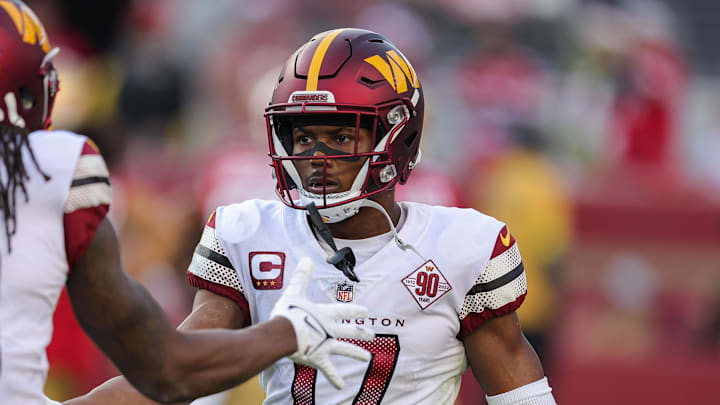Terry McLaurin is the best player on the Washington Commanders' offense, but there's room for improvement. Especially if new offensive coordinator Eric Bieniemy borrows a page from franchise history.
Art Monk is a Pro Football Hall of Famer thanks to retiring as the franchise's all-time leading receiver with 88 receptions for 12,026 yards. The prolific wideout dominated during 14 seasons because of the way legendary head coach Joe Gibbs used his talents.
Gibbs kept on putting Monk in motion. This is something Eric Bieniemy can do more often with Terry McLaurin, who spent most of his time hugging the sideline in 2022.
McLaurin lined up outside for 78.9 percent of his snaps, according to Braxton Howard of Pro Football Focus. But the Washington Commanders scheme was hardly the most inspiring under previous offensive coordinator Scott Turner.
"[Terry] McLaurin leads all the players on this list in wide snap percentage. And among the 26 wide receivers who saw over 100 snaps of single coverage on the outside last season, the Commanders star ranked second in average depth of target (19.0 yards downfield)."Braxton Howard, PFF
Terry McLaurin can be even better for the Commanders in Art Monk role
'Scary Terry' is a force from anywhere on the field, but aligning him outside so often makes Bieniemy's best receiver one-dimensional and easy to defend. Gibbs knew not to limit the ways a multi-faceted wide receiver can attack defenses. It's why he kept Monk on the move.
Monk's movement reaped the most rewards during the 1984 season when he set a then-NFL record with 106 receptions. He clinched the mark with a typically clutch grab to help settle a frenetic NFC East title showdown with the St. Louis Cardinals at RFK Stadium.
Writing for NBC Sports, the late Rich Tandler described this catch 20 years later:
"Joe Gibbs had to try to find a way to hide Monk, inasmuch as that was possible. He sent in a play and formation that he had just installed that week called Two Divide. It called for Monk to line up at tight end on the right side. He fought his way off the line, found a hole on the right sideline and, Monk said, “The ball was perfect.” It worked for a 20 yards and the first down at the 27. On the day, Monk caught 11 passes for 138 yards"Rich Tandler, NBC Sports
What stands out is Monk lining up at tight end. Putting tight ends on the move came from Gibbs' experience as offensive coordinator for the famed 'Air Coryell' San Diego Chargers. He helped the organization to properly use "Roving Y" tight end Kellen Winslow Sr.
Gibbs' influence was explained in the book The Games That Changed The Game by Ron Jaworski with Greg Cosell and David Plaut:
"It pained Joe Gibbs to see Winslow's talent being held back by the traditional limits of the position. When we lined him up at the standard tight end spot and he went to release, he got pounded by the outside linebacker in a 4-3 or the inside linebacker in a 3-4; he recalled. He had a tough time getting off clean, and we felt we had to do something. So Ernie, Don, our O-line coach, Jim Hanifan, and I said to ourselves, Maybe the thing to do is take him off that line of scrimmage and start moving him all over the place."Ron Jaworski
Those same principles made Monk a roving weapon. As William Nack of Sports Illustrated once put it, "The abiding image of him is as the man in motion at the snap. Five yards across the line he slants toward the sideline or breaks for the middle."
That image became part of history when Monk made his 820th career catch against the Denver Broncos in 1992. It was then the all-time record and fittingly began with Monk drifting in motion, per Old Time Football.
Happy Birthday Art Monk.
— Old Time Football 🏈 (@Ol_TimeFootball) December 5, 2021
On October 12, 1992 Art became the #NFL All-Time receptions leader when he caught his 820th pass.#WashingtonFootball
pic.twitter.com/5pWtGHunA2
The same schematic blueprint can work for McLaurin, who has already shown an aptitude for thriving inside. He was the 10th most active receiver from the slot in 2020, according to PFF Commanders.
McLaurin knows how to read coverage and exploit space over the middle, like for this catch against the Tennessee Titans, highlighted by Commanders' film analyst Mark Bullock.
Terry McLaurin in the slot out of empty is a problem for opposing defenses. Excellent work after the catch pic.twitter.com/fNpg5ZewuY
— Mark Bullock (@MarkBullockNFL) October 9, 2022
Playing No. 17 inside would help Bieniemy and the Commanders mask a lack of options at tight end, but he doesn't need to restrict McLaurin to the slot, just send him in motion more often. It'll mess with coverage assignments and hide him from defenses.
Motioning McLaurin can also draw attention away from other targets and give Commanders' quarterback Sam Howell easy throws to the outside. The Minnesota Vikings showed how on a play highlighted by Nate Tice of The Athletic, that involved sending Justin Jefferson in motion for the umpteenth time against the New York Giants.
watch how Justin Jefferson’s motion from a Bunch alignment on 3rd & 3 causes some hesitation from the Giants defenders.
— Nate Tice (@Nate_Tice) January 15, 2023
TJ Hockenson not only gains leverage for his route but KJ Osborn’s outside release helps create even more space. pic.twitter.com/TmHgxq6pCf
Jefferson dominated in 2022 thanks to how often he went in motion. McLaurin can reach the same heights as the clutch chain-mover who can make Jahan Dotson and Curtis Samuel more effective on the outside, the way Monk did for Gary Clark and Ricky Sanders.
